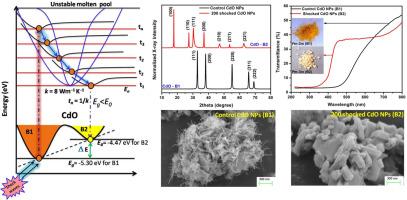声波激波诱导的CdO纳米颗粒B1到B2相变:结构-性能关系及其热力学机制
IF 8.3
1区 材料科学
Q1 MATERIALS SCIENCE, MULTIDISCIPLINARY
引用次数: 0
摘要
可逆压力诱导的B1 (NaCl)↔B2 (CsCl)型相变是理解相变一般概念的经典模型之一。尽管在高压条件下,B2相材料具有一些突出的功能特性,但在环境条件下产生稳定的B2相是器件制造的关键任务。在此,我们报告了在环境条件下高度稳定的毫秒低压声波冲击波(16.5 MPa和3173 K)下氧化镉纳米颗粒(CdO NPs)的b1 - b2型相变。在静态高压条件下,B1-B2相变需要~ 102 GPa,这是可逆的。提出了一种新的热力学机制来解释考虑热导率的B1-B2转变,即低热导率的材料在声冲击条件下发生显著的结构相变。在此,我们考虑了几种纳米材料的结构稳定性,包括B1 (CdO, MgO, NiO),刚玉(α-Fe2O3, α-Al2O3),层状(石墨烯,石墨)和非层状(TiO2(锐钛矿),ZnO (B4)和无定形碳)材料,在声冲击条件下,属于所提出的机制。本文章由计算机程序翻译,如有差异,请以英文原文为准。


Acoustic shock wave-induced B1 to B2 phase transition of CdO nanoparticles: Structure-property relationship and its mechanism in thermodynamic aspects
The reversible pressure-induced B1 (NaCl) ↔ B2 (CsCl)-type phase transition is one of the classic models for understanding the general concepts of phase transition. Although several outstanding functional properties have been identified for B2 phase materials under high-pressure conditions, generating a stable B2 phase under ambient conditions is a critical task for device fabrication. Herein, we report a novel B1-B2-type phase transition in cadmium oxide nanoparticles (CdO NPs) by millisecond-low-pressure acoustic shock waves (16.5 MPa and 3173 K) that is highly stable under ambient conditions. Under static high-pressure conditions, the B1-B2 phase transition requires ∼102 GPa, which is reversible. A new thermodynamic mechanism is proposed to explain the B1-B2 transition considering the thermal conductivity, whereby materials with low thermal conductivity undergo significant structural phase transitions under acoustic shocked conditions. Herein, we consider several nanosized materials for structural stability, including B1 (CdO, MgO, NiO), Corundum (α-Fe2O3, α-Al2O3), layered (graphene, graphite) and nonlayered (TiO2 (anatase), ZnO (B4) and amorphous carbon) materials, under acoustic shocked conditions, which fall within the proposed mechanism.
求助全文
通过发布文献求助,成功后即可免费获取论文全文。
去求助
来源期刊

Acta Materialia
工程技术-材料科学:综合
CiteScore
16.10
自引率
8.50%
发文量
801
审稿时长
53 days
期刊介绍:
Acta Materialia serves as a platform for publishing full-length, original papers and commissioned overviews that contribute to a profound understanding of the correlation between the processing, structure, and properties of inorganic materials. The journal seeks papers with high impact potential or those that significantly propel the field forward. The scope includes the atomic and molecular arrangements, chemical and electronic structures, and microstructure of materials, focusing on their mechanical or functional behavior across all length scales, including nanostructures.
 求助内容:
求助内容: 应助结果提醒方式:
应助结果提醒方式:


